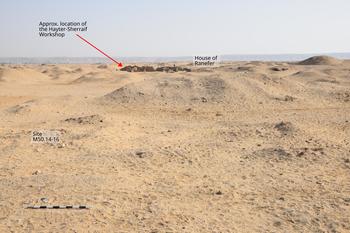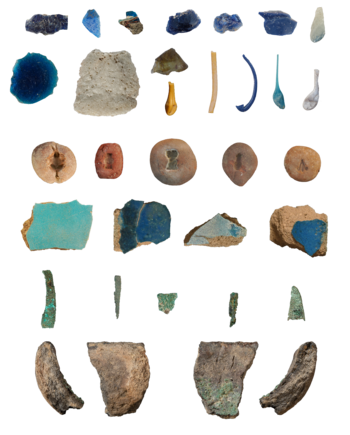Craft Interactions in a New Kingdom Industrial Landscape (Egypt, 1550–1069 BCE)
- Dr. Frederik W. Rademakers (British Museum, London: Department of Scientific Research)
- AHRC: Arts and Humanities Research Council
- DFG: Deutsche Forschungsgemeinschaft
Location of the Hayter-Sherraif Workshop
Image Credit: Photo: A.K. Hodgkinson.
Selection of finds
Image Credit: Photos: A. Mesli and A.K. Hodgkinson.
Project Summary
This project charts for the first time the interaction between high-temperature technologies in New Kingdom Egypt (1550–1069 BCE). It focuses on a pivotal time in history when industrial-scale glass production was developed alongside growing copper alloy, faience and pigment manufacture and these materials were conspicuously exchanged throughout the Mediterranean. Although these high-temperature industries have been examined individually to varying extent, this project proposes a paradigm shift is needed to fully understand them in light of each other. This project introduces an integrated methodology, reconsidering archaeological evidence as a reflection of wider production networks (réseaux opératoires) rather than individual material production chains (chaînes opératoires) to assess the extent of entanglement between different high-temperature technologies. As such, the project attempts to fundamentally change our understanding of ancient societies by explicitly examining the flow of materials and people between crafts in the past.
Research Questions and Methods
To examine New Kingdom production networks, the project focuses primarily on the site of Amarna (ancient Akhetaten, Middle Egypt, 18th Dynasty, c. 1353–1336 BCE), which provides exceptionally extensive evidence for different high-temperature crafts. This project seeks to address three fundamental research questions:
1. Can cross-craft interaction better explain New Kingdom technologies?
Craft interrelations are widely assumed in archaeological studies of technology but rarely built into research designs. Identifying these interactions can offer new pathways towards understanding the social contexts of production, the mobility of craftspeople within urban environments and the exchange of materials and ideas. Previous studies have already shown such interplay existed during the New Kingdom, yet mapping its extent and complexity requires a consistent approach.
2. How were high-temperature crafts organised at Amarna?
The project examines the organisation and interplay of Egyptian high-temperature technologies, in particular with regard to the origins and cross-craft flow of materials on an urban and regional level. This will be achieved through a novel implementation of state-of-the-art analytical methods contextualised by fresh excavation at Amarna (the Hayter-Sherraif Workshop) and guided by ground-breaking laboratory-based experimentation.
3. To what extent was craft organisation at Amarna different to earlier and later New Kingdom sites?
Parallels with other 18th–20th Dynasty urban sites (Malqata, Amara West, Gurob and Pi-Ramesse) will be examined to assess how craft organisation at Amarna can serve as a model for urban practices in Egypt and the wider Mediterranean world.
Aims and Objectives
To achieve this new understanding of urban craft organisation, the project aims to:
- Create a multi-faceted overview of cross-craft interaction during the New Kingdom, and in particular at 18th Dynasty Amarna,
- Unite UK- and Germany-based collections of material from Amarna to develop a cross-national database of analytical data for the site and New Kingdom Egypt in general,
- Develop new interdisciplinary tools for the analysis of ancient Egyptian materials and high-temperature workshop contexts,
- Produce ground-breaking reference data to enable the assessment of craft entanglement and technological exchange along the Nile and the wider Mediterranean world.
This will be achieved through an interdisciplinary methodology combining archaeological fieldwork (at Amarna), lab-based experiments and scientific analysis of production remains and finished objects (on-site and across museum collections).
The project fosters intimate and long-term collaboration between several well-established research institutions. It seeks to (virtually) reunite archaeological assemblages dispersed between European museum institutions at the turn of the 20th century, improving their overall contextual understanding and utility for the individual partners and international scholars alike. It aims to be a model for future studies of site assemblages across the ancient world and enable collaborative projects on other underexplored parts of museum collections worldwide by providing a comprehensive methodology.
Main Project Partner:
British Museum, London
Other Project Partners:
- The Amarna Project, University of Cambridge (Cambridge, United Kingdom)
- Ägyptisches Museum und Papyrussammlung, Staatliche Museen zu Berlin, Preußischer Kulturbesitz (Berlin, Germany)
- Rathgen-Forschungslabor, Staatliche Museen zu Berlin, Preußischer Kulturbesitz (Berlin, Germany)
- Petrie Museum of Egyptian and Sudanese Archaeology, University College London (London, United Kingdom)
- Qantir-Pi-Ramesse Project (Hildesheim, Germany)
- KU Leuven (Leuven, Belgium)
Keywords
- Egyptian archaeology, ancient technology, ancient copper alloys, ancient glass, ancient pigments, ancient faience, Amarna, New Kingdom

